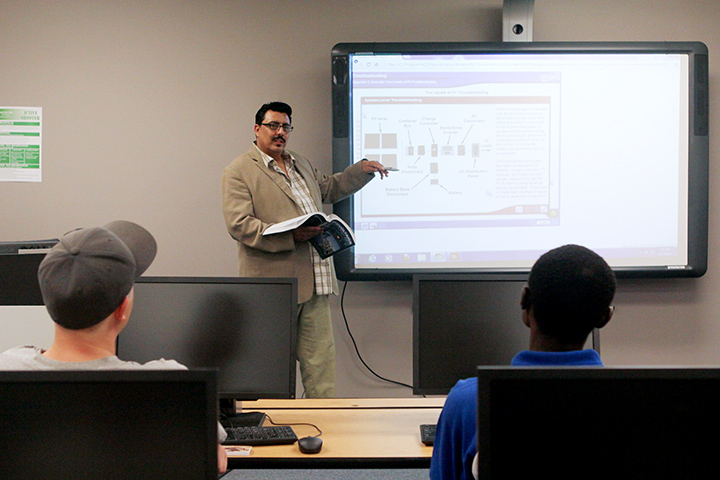
ASU engineering grad putting education to work in solar energy field

Manny Quijada is pictured teaching a class on photovoltaic solar-energy systems recently at Western Texas College. Quijada earned a master’s degree in solar energy engineering and commercialization at Arizona State University in 2011.
Posted October 29, 2013
Western Texas College launched its Solar Energy Technology program a year ago under the direction of Manny Quijada, who in December 2011 earned his professional science master’s degree through the Solar Energy Engineering and Commercialization program at Arizona State University.
Aided by Quijada’s expertise, the Texas college is now offering students an introduction to the solar energy industry, with a focus on advanced education in photovoltaic and thermal technologies for harvesting solar energy. The program also supports workforce training in the local community, where solar energy-related businesses are growing.
As a solar energy curriculum specialist, Quijada is designing competency-based curriculum and overseeing its implementation and development. He is piloting instruction of the courses in lecture and lab environments, as well as coordinating the development of online/classroom hybrid courses.
He is also doing work aimed at demonstrating to communities in the region the potential long-term benefits of renewable energy sources for businesses and residents.
“I’m excited to be immediately applying the breadth of knowledge I gained in the master’s program” at ASU, he says.
Technical and business skills
The Solar Energy Engineering and Commercialization program is administered by the School for Engineering of Matter, Transport and Energy, one of ASU’s Ira A. Fulton Schools of Engineering.
The program equipped him with everything he has needed to do his job at Western Texas College, Quijada says. He learned the science, engineering and technological aspects of solar energy, along with the economics, business and policy sides of the industry.
He came into to the master’s degree program after earning a bachelor’s degree at ASU, concentrating on studies in electronic energy systems and alternative energy in the College of Technology and Innovation. There he received experience in the installation of photovoltaic systems – learning how to measure and forecast the performance and reliability of the systems. He also developed models to predict the performance of systems over their life spans.
Hands-on learning outside the classroom continued in the master’s program. Quijada interned as a testing engineer for the photovoltaic testing laboratory TUV Rheinland, headquartered near ASU’s Tempe campus.
Work on his applied project in the program boosted his mastery of the mechanical aspects of installing solar array systems.
As part of his education in the public policy aspects of the field, he met leaders of energy industry enterprises in Arizona and traveled to Washington, D.C., for a workshop on national and international energy policy making that is offered in partnership with ASU’s Consortium for Science and Policy Outcomes.
Industry connections
The ASU program began in January 2011 with the aid of a National Science Foundation grant. Twenty-seven students have since earned masters’ degrees through the program and 11 more are on track to graduate.
It enables students with undergraduate training in STEM subjects – science, technology, engineering and math – to expand their education across areas such as energy engineering, project management, energy policy, utility regulation and professional ethics, among other related fields.
An industrial advisory board guides the curriculum, helping to ensure courses provide knowledge and skills relevant to the ever-evolving solar energy industry. Students also benefit from an industry advisor in addition to a faculty advisor to guide their applied projects.
The program is designed to enable students to complete studies for their degree in a year by taking full course loads for three consecutive semesters, but students are also welcome to pursue the degree on a part-time schedule.
Looking to the future
Quijada says what he learned in the program has qualified him to teach, do research, lead policy development or perform in a technical or management role in the energy industry. He’s now expanding on those qualifications by pursuing a doctoral degree in management with a focus on organizational leadership.
“I’m thrilled to be in a position where I can motivate others to learn about solar energy technology and to envision a future for this power source that can help nations and governments secure a sustainable environment,” he says.
Written by Rosie Gochnour and Joe Kullman
Media Contact:
Joe Kullman, [email protected]
(480) 965-8122
Ira A. Fulton Schools of Engineering



































